Frank James
by Franke James, Blog Action Day 2009
Six tools for Climate Change Art? What’s that about? Many people reading this — maybe even you — will claim, “I’m not an artist or an activist. I can’t even draw a straight line… How can I make climate change art?”
But art (and activism) is NOT about drawing straight lines. It’s about getting the idea that’s in your head — out into the world, so others can see it and understand your point of view. It’s about using your “voice.”
Many people are anxious about climate change and feel powerless. Making art can help you — and the world. Art in all its myriad forms (visual, dance, music, poetry, performance art, direct action and now even flash mobs) has been central to making social change happen. You can be part of it. I want to inspire you to take concrete action. And share your ideas on climate change with friends, family — and possibly even a much wider circle. (I think you’ll also have FUN doing this.)
So, let me share with you my Six Tools for making climate change art. They are intended to help anyone — even the most-analytical-I-can’t-draw-a-straight-line-but-I-do-have-an-opinion kind of person express themselves visually.
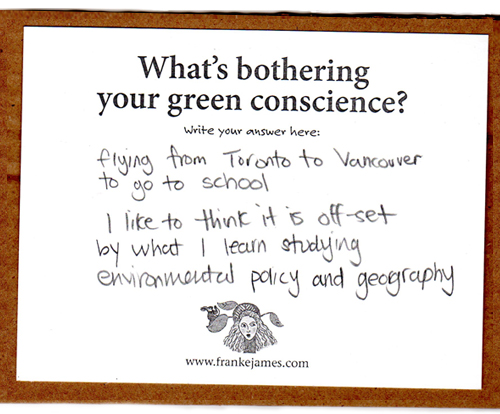
What are the Six Tools to make climate change art?
And why were they developed?
Two years ago, I was invited by the McMichael Gallery to present “A Green Winter: Will Global Warming Be Good for Canada?” with the idea that it would give students an example of ‘new media’ climate change art.
So, I started with two very simple ideas.
#1. I wanted the students to understand that artists can make a difference in the world. #2. I wanted to give them the tools to make climate change art on their own — so I wrote down the six tools I rely on. When you see my list of six tools you will nod your head in recognition. These are all familiar tools that everyone can use. We just have to be creative — and judicious — in choosing the right tool to communicate the idea, so that our artwork can be memorable AND inspire action.
Why Just Six Tools?
OK. There are more than Six Tools — but six is a good start to help you structure your thinking. Most importantly, the tools apply to ALL forms of art. For this post, I’ll be talking about collage, but once you understand how the Six Tools work, you’ll see they are the basis of all great art and communication.
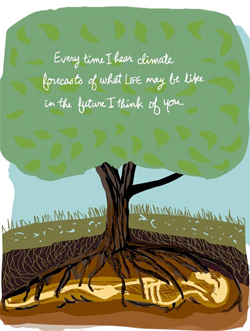
6 Tools to Make Climate Change Art
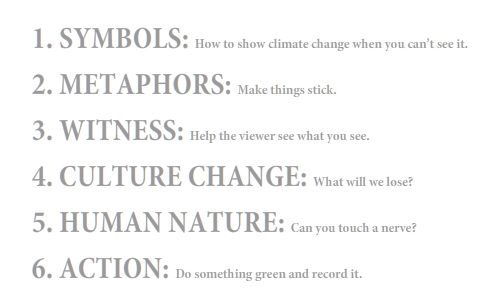
The response to the Six Tools has been very positive. Since 2007, I’ve seen non-artists (and artists) create powerful and expressive artworks using the Six Tools method. I’ve spoken to teachers and students from junior high school to university level in Canada and the USA. A recent climate change camp for teachers resulted in Sparking Your Green Conscience being integrated into a lesson plan for Ontario teachers. It’s now available as a teacher resource on the OTF website.
(At the end of this post are my tips for doing the Six Tools Workshop, on your own, complete with a list of materials required.)
Each workshop starts with a question:
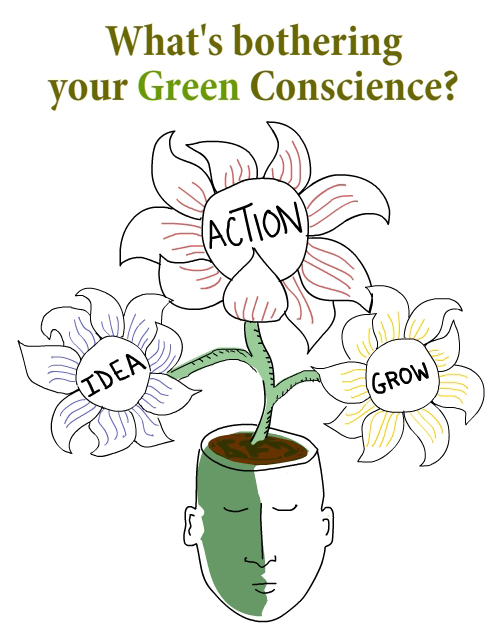
Do you have a Green Conscience?
Here’s a quick quiz if you want to find out.
I’ve been bothered by my green conscience for awhile and it’s spurred me to do all sorts of things — like selling our only car (an SUV), and challenging City Hall for the right to build a green driveway.
But it also made me curious… I started asking other people what’s bothering theirs… I’ve asked the question on Twitter, talked to students in art workshops, and at many other events. So, I can say confidently that while most people don’t think of themselves as ‘environmentalists’ — almost everyone has a green conscience that bothers them on a daily basis. That little voice saying, ‘Oh, I shouldn’t throw that in the trash, it goes in recycling…’
Knowing that everyone has something that nags at them, I start my workshops with the simple question, “What’s bothering your green conscience?” And I am amazed by how varied the responses are (which you’ll see examples of later on). Using the green conscience question as the focus for their climate change art, I then lead them through the Six Tools — it’s an easy way to help people express ideas visually.
1. Symbols: How to show climate change when you can’t see it
Symbols are powerful and they are everywhere! In the illustration below I’ve combined two universally recognized symbols.
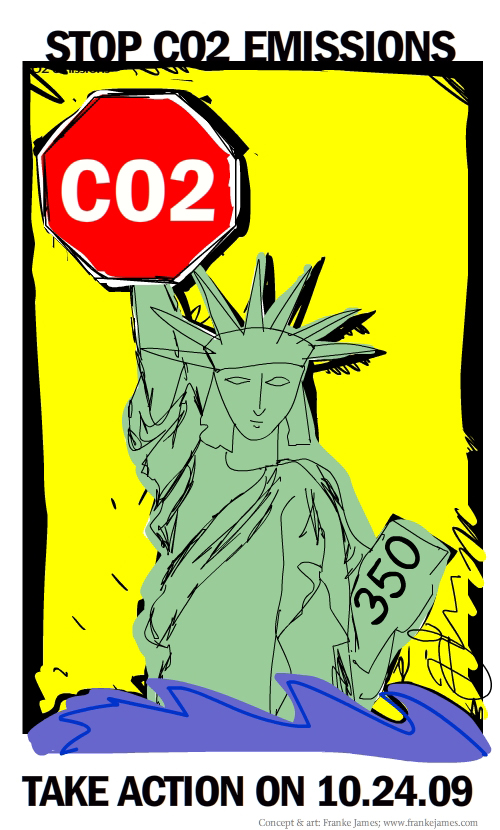
The Statue of Liberty holds up a Stop Sign
The stop sign and the Statue of Liberty are not new, but the juxtaposition of the two (with CO2 replacing the word “stop”) makes you look at them in a new way. It is ironic that the Statue of Liberty really is green. Will the United States embrace their giant green woman and lead the world in reducing CO2 emissions?
The Visionary Human Eye
The eye is a symbol that has been used throughout art history to great effect. My “eyeball” illustration below is from A Green Winter. In that real-life story, Freakonomics author and rogue economist Steven Levitt calls me a “visionary” for worrying about global warming. I was flabbergasted and responded, “Excuse me — I’m a visionary for worrying about global warming??” I don’t know if a camera would have captured the look of dumbfoundedness on my face, but the bloodshot eyeball/globe quickly communicates how I felt.






